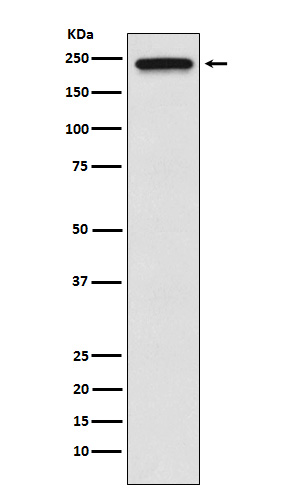
| WB | 咨询技术 | Human,Mouse,Rat |
| IF | 咨询技术 | Human,Mouse,Rat |
| IHC | 咨询技术 | Human,Mouse,Rat |
| ICC | 1/50-1/200 | Human,Mouse,Rat |
| FCM | 1/20-1/100 | Human,Mouse,Rat |
| Elisa | 咨询技术 | Human,Mouse,Rat |
| Aliases | ALSPDC; CHAK; CHAK1; LTrpC7; TRPM7;;TRPM7 |
| WB Predicted band size | 213 kDa |
| Host/Isotype | Rabbit IgG |
| Antibody Type | Primary antibody |
| Storage | Store at 4°C short term. Aliquot and store at -20°C long term. Avoid freeze/thaw cycles. |
| Species Reactivity | Human,Mouse,Rat |
| Immunogen | A synthesized peptide derived from human TRPM7 |
| Formulation | Purified antibody in PBS with 0.05% sodium azide,0.05% BSA and 50% glycerol. |
+ +
以下是关于TRPM7抗体的3篇代表性文献(摘要内容已简化):
1. **"TRPM7 is essential for Mg²⁺ homeostasis in mammals"**
- 作者:Chubanov, V., et al.
- 摘要:通过基因敲除模型和特异性TRPM7抗体,研究证实TRPM7在维持细胞内镁离子平衡中的关键作用,抗体用于检测组织及细胞系中TRPM7的蛋白表达缺失。
2. **"TRPM7 channel is regulated by magnesium nucleotides via its kinase domain"**
- 作者:Nadler, M.J.S., et al.
- 摘要:首次报道TRPM7通道的激酶结构域功能,使用TRPM7特异性抗体验证其在HEK293细胞中的过表达,并揭示其受镁离子及ATP调控的分子机制。
3. **"TRPM7 modulates human glioblastoma proliferation through MAPK signaling"**
- 作者:Jin, J., et al.
- 摘要:通过免疫组化(使用TRPM7抗体)发现其在胶质母细胞瘤中高表达,并证明抑制TRPM7可通过MAPK通路降低肿瘤细胞增殖,提示其作为治疗靶点的潜力。
注:实际文献引用需根据具体研究内容选择,建议通过PubMed或Google Scholar以“TRPM7 antibody”为关键词检索最新文章。
The TRPM7 (Transient Receptor Potential Melastatin 7) antibody is a key tool for studying the dual-function TRPM7 protein, which combines an ion channel permeable to divalent cations (e.g., Mg²⁺, Ca²⁺) with a serine/threonine kinase domain. TRPM7 plays critical roles in cellular processes like magnesium homeostasis, cell proliferation, apoptosis, and embryonic development. Dysregulation of TRPM7 is linked to pathologies including neurodegenerative diseases, cardiovascular disorders, and cancer metastasis.
TRPM7 antibodies are designed to detect specific epitopes of the protein, enabling researchers to investigate its expression, localization, and post-translational modifications. These antibodies are widely used in techniques such as Western blotting, immunohistochemistry (IHC), and immunofluorescence (IF) to study TRPM7 in various tissues and cell types. Challenges in antibody development arise from TRPM7’s structural complexity, particularly the shared homology between its kinase domain and other TRPM family members. Validation of specificity via knockout controls or siRNA knockdown is essential to avoid cross-reactivity.
Research utilizing TRPM7 antibodies has advanced understanding of its signaling mechanisms, such as interactions with downstream targets like myosin II or immunophilin FKBP38. Such studies highlight its potential as a therapeutic target, driving interest in inhibitors for diseases involving abnormal TRPM7 activity.
×